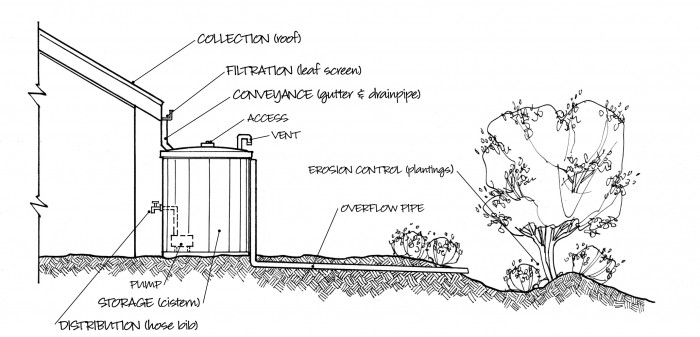The PermaDesign Weblog, with Nate Downey and Melissa McDonald!
Roof-Reliant Landscaping™ Step 8: Cisterns are Systems

Although it is accurate to say that a cistern is a water storage tank, the term cistern, as used in this manual, is much more than a container. In roof-reliant landscaping, a cistern denotes a functioning water-storage system, not simply the shape and the material that make up the water tank’s walls. A cistern system includes the storage tank and its relationship and connection to each of its constituent parts.
The complexity of cistern systems vary widely from aboveground systems that distribute collected water via standard, manually operated garden hoses to underground systems that use the latest technology to automatically distribute water to landscape plants using an intricate network of drip irrigation components. Regardless of the precise form of your system’s anatomy, your roof-reliant cistern system will perform four basic functions: collection, conveyance, storage and distribution.
Roofs are particularly well suited as water collection surfaces. The sloped surfaces of roofs efficiently use the force of gravity to direct rainwater downward. (Even so-called flat roofs are slightly sloped.) Water collected off a roof is relatively clean and healthy when used for irrigation purposes only.
In roof-reliant landscaping, conveyance systems move roof water from precipitation collection surfaces to cisterns. In a basic water collection system, a downspout or canale funnels water directly into an aboveground rainbarrel or cistern for storage. In the more complicated system pictured above, the water in the conveyance system must pass through gutters, downspouts, a leaf screen, a firstflush device, a sediment trap and conveyance piping before it is delivered to the cistern. The distribution of cistern water to the root zones of plants is the final act of water harvesting.Although collecting, conveying and storing roof water is often referred to as rainwater harvesting, the entire function of harvesting is not completed until the water has been effectively distributed.
09/23/2015 | (0) Comments










Comments